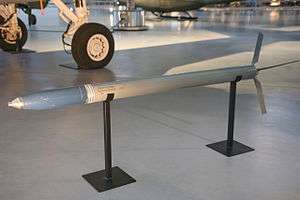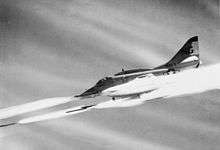Zuni (rocket)
The Zuni 5-inch Folding-Fin Aircraft Rocket (FFAR), or simply Zuni, is a 5.0 in (127 mm) unguided rocket developed by the Hunter-Douglas Division of Bridgeport Brass Company and deployed by the United States armed forces.[1][2] The rocket was developed for both air-to-air and air-to-ground operations. It can be used to carry various types of warheads, including chaff for countermeasures. It is usually fired from the LAU-10 rocket pod holding four rockets.
| Zuni | |
|---|---|
 | |
| Type | Air-to-surface rocket |
| Place of origin | United States |
| Service history | |
| Used by | United States military |
| Production history | |
| Produced | 1957–present |
| Specifications | |
| Mass | 79.5 pounds (36.1 kg) (motor only) |
| Length | 77 inches (2,000 mm) |
| Diameter | 5 inches (130 mm) |
| Warhead | various |
| Engine | Solid-fuel rocket |
Operational range | 5 miles (8.0 km) |
| Maximum speed | 1,615 miles per hour (2,599 km/h) |
Guidance system | None |
Development
In the early 1950s, U.S. Navy engineers Naval Ordnance Test Station China Lake began to develop a new 12.7 cm unguided rocket to replace the High Velocity Aircraft Rocket.

The Zuni was designed as a modular system, to allow the use of different types of warheads and fuzes. One type of warhead had a proximity fuze, as the rocket was originally intended to be used as an air-to-air rocket. This led to its selection as the basis for the AIM-9 Sidewinder airframe in the early 1950s.
The Zuni was approved for production in 1957. A number of different launchers were tested for the Zuni, e.g. single launchers fitted to the Sidewinder launching rails of the Vought F-8 Crusader. However, four-tube LAU-10/A series pods became the most commonly used launcher.[3]
The Zuni was named after the Zuni Native American tribe in modern day New Mexico.[4]
Operational history

The Zuni was widely used in the ground-attack role during the Vietnam War.
On May 1, 1967, during a sortie against Kép Air Base, North Vietnam, Lieutenant Commander Theodore R. Swartz of Squadron VA-76, flying from USS Bon Homme Richard, shot down a MiG-17 with Zuni rockets. This was the only MiG aircraft to be downed by a Douglas A-4 Skyhawk during the Vietnam War.[5] Lieutenant Commander Swartz received the Silver Star for his action.[6]
Later that year, improper handling of a Mk 32 Zuni rocket was responsible for a serious fire aboard USS Forrestal aircraft carrier, which killed 134 men. Two years later, in early 1969, a similar incident on the USS Enterprise aircraft carrier resulted in 27 dead, 314 injured and the loss of fifteen aircraft.[7]
Rocket motors and warheads
The Zuni family consists out of several different rocket motors and warheads:
| Designation | Weight | Thrust | Length |
|---|---|---|---|
| Mk.16 | 56.5 lbs (25.6kg) | 7500 lbs (33.3KN) for 1.04s | 77 in (2m) |
| Mk.71 Mod.0 | 66.85 lbs (30.3kg) | 7780 lbs (34.6KN) for 1.17s | 76.3 in (1.9m) |
| Mk.71 Mod.1 | 79.5 lbs (36kg) | 8100 lbs (36KN) for 1.8s | 82.3 in (2.1m) |
| Warhead designation | Type | Weight | Filler | Additional information |
|---|---|---|---|---|
| Mk.24 | HE | 48 lbs (21.7kg) | 9.5 lbs (4.3kg) Comp.B | The head produces over 500 fragments that penetrate up to 3/8" (9.5mm) mild steel at 30ft (9.1m) distance upon detonation.
When using the Mk.191 base detonating fuze this warhead can penetrate:
|
| Mk.32 | ATAP (Anti-Tank Anti Personnel)/ HEAT-FRAG | 45.7 lbs (20,72kg) | 15 lbs (6.8kg) Comp.B | The head produces over 2000 1/4" (6.35mm) square fragments that are capable of damaging light vehicles in a radius of 70ft (21.3m)
When issued with a point detonating fuze the HEAT warhead penetrates:
|
| Mk.33 | Illumination | 46 lbs (20.8kg) | 7lbs (3.17kg) pyrotechnic material | Flare burns 70 seconds at 1,750,000 cp |
| Mk.34 | Smoke | 51 lbs (23kg) | 19.3 lbs (8.7kg) WP | |
| Mk.63 | HE-Frag | 56.5 lbs (25.6kg) | 15 lbs (6.8kg) Comp.B | |
| Mk.84 | Chaff | 47 lbs (21.3kg) | 12 chaff cassetts | |
| Practice | Practice | same as simulated warhead Mod. | inert |
Student use
The Australian Government has donated its Zuni rockets to the Australian Space Research Institute (ASRI) and they are used for student experiments which are launched from the Woomera launching range. Every year a few Zunis are launched there.
ASRI has also designed and constructed custom nosecones and payload recovery mechanisms for the Zuni. With a payload of 20 kg, the Zuni has an approximate range of 5.9 km, which it attains in about 40 seconds, experiencing 55 g and 491 m/s (Mach 1.4) during the flight.
Laser Guided Zuni Rocket
The 5-inch (127 mm) Laser Guided Zuni Rocket is a precision weapon and an upgrade to the unguided Zuni rocket. The North American division of MBDA is the only manufacturer of the Laser Guided Zuni Rocket,[13] which is similar to the Advanced Precision Kill Weapon System upgrade to the Hydra 70 system.[14] The Laser Guided Zuni Rocket is composed of the new WGU-58/B Guidance and Control Section that is attached to the front end of an unguided Zuni rocket and warhead. The weapon requires semi-active laser energy to guide to a precise target.[15] The Laser Guided Zuni Rocket is on the U.S. Marine Corps Aviation Weapons Roadmap and Plan[14] and is compatible with any aircraft that is cleared to carry unguided Zunis in a four-place LAU-10 Launcher, including AV-8B Harriers, F/A-18 Hornets, AH-1 Cobra helicopters and P-3 Orion aircraft.[13] The precision weapon fits in the same launcher as unguided Zunis and requires only a 28V firing pulse and a semi-active laser designator. The weapon was developed under a Cooperative Research and Development Agreement (CRADA) with the Weapons Division of the U.S. Navy's Air Warfare Center in China Lake, California (NAWC WD).[16]
In 2009, the Laser Guided Zuni Rocket was successfully tested against both a stationary[15] and moving targets.[16][17] The weapon successfully underwent a live fire warhead test flight in September 2010.[18]
References
- Notes
- "Zuni 5.0-Inch [130 mm] Rocket". Retrieved December 27, 2015.
- "Zuni Missile". Retrieved September 14, 2017.
- "Air-Launched 5-Inch Rockets". Retrieved December 27, 2015.
- "Zuni missile". National Air and Space Museum. Retrieved May 19, 2020.
- Grossnick and Armstrong 1997
- Marolda, Edward J. (1 July 1996). By Sea, Air, and Land: An Illustrated History of the U. S. Navy and the War in Southeast Asia. DIANE Publishing. p. 391 – via Internet Archive.
theodore swartz 1 may 1967.
- "The USS ENTERPRISE (CVAN-65) fire and munition explosions - The History of Insensitive Munitions". www.insensitivemunitions.org.
- NAVWEAPS OP2210 Aircraft Rockets June 1960
- OV-10 bronco Tactical manual - Page 119
- "Air-Launched 5-Inch Rockets". www.designation-systems.net. Retrieved 2019-02-09.
- OV-10 Bronco tactical manual - Page 114
- 5 inch Folding Fin Aircraft Rockt Zuni NAVWEPS OP 2626
- WGU-58/B Laser Guided Zuni Rocket Data Sheet Archived April 8, 2011, at the Wayback Machine
- "2007 Marine Aviation Plan2007 Marine Aviation Plan" (PDF). Archived from the original (PDF) on November 27, 2007.
- Laser Guided Zuni (TM) Stationary Target Composite Video Public Release May, 2009. January 9, 2010. Retrieved December 27, 2015 – via YouTube.
- Laser Guided Zuni (TM) Moving Target Shot August, 2009. January 9, 2010. Retrieved December 27, 2015 – via YouTube.
- Archived October 17, 2010, at the Wayback Machine
- "MBDA Inc. - MBDA Inc Missile Systems". MBDA Inc. Retrieved December 27, 2015.
- Bibliography
- Grossnick, R. and Armstrong W.J. (1997). United States Naval Aviation, 1910–1995. Naval Historical Center. ISBN 0-16-049124-X.
External links
